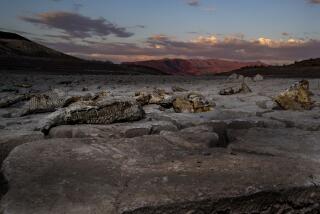South Parched by Historic Drought
CONCORD, N.C. — Each day before they leave their western North Carolina home, Marcine and Arne Fennel clasp hands, close their eyes and pray.
These days, in particular, they are praying for rain to fill the depleted lakes and end the worst drought their area has seen in 50 years.
“Has the rain a father?” Mrs. Fennel, quoting from the Book of Job, asks, her right hand raised palmward to the sky. “Can you lift up your voice to the clouds, that an abundance of water may cover you?”
“Lord,” her husband rejoins, “we ask that you bring the rain. Replenish our land. Replenish our streams, our lakes, our reservoirs. Lord God, bring us the rain so that we may survive.”
Similar prayers can be heard all across the South, which is in its third straight year of drought.
Florida has been gripped since 1998 by the worst dry spell since records started being kept in 1895. Mighty Lake Okeechobee is so dry that exposed water vegetation has caught fire.
In central Georgia, farmers planting this year’s corn crop kick up clouds of dust plowing fields that a new 4-inch soaking barely penetrated. North Carolina just finished the second-driest winter on record. Scientists even suspect the lack of fresh water reaching estuaries could be behind last year’s low white shrimp harvest off the coasts of South Carolina and Georgia.
The region is supposed to be entering another wet season, but officials aren’t counting their chickens just yet.
“Certainly for ground water it’ll be a year before it catches up, unless we get several tropical storms or hurricanes,” says Jim O’Brien, Florida’s state climatologist. “If they want their bream pond to come back, they need a hurricane.”
Most of Florida, a large swath of western North Carolina and a small area of northern South Carolina are under extreme or exceptional drought conditions, according to the latest Drought Monitor.
Most of Georgia and the Carolinas are experiencing moderate drought. And large areas of Kentucky, Tennessee, eastern North Carolina and southern Virginia are abnormally dry.
That might surprise anyone who dropped into central Georgia or parts of the Carolinas in recent weeks. Heavy downpours soaked large areas.
“It was too wet to even get my tractor out in there,” says Sam Baker, drought specialist at the Southeast Regional Climate Center in Columbia, S.C. “But that doesn’t mean that if I dig down a foot and a half to put in a post that I’m not going to get in just powder-dry soil.”
So far this year, there seems to be plenty of moisture in the soil--too much for some farmers, says David Stooksbury, Georgia’s state climatologist. But he is warning people not to get fooled.
“When we’re in a drought, everything still looks green,” he says. “ . . . The South doesn’t dry up and look like a desert in a drought.”
Much of the region is in what is known as a hydrological drought, meaning stream and reservoir levels are low, and rainfall hasn’t been enough to recharge the systems.
Lake Lanier, the primary water source for metropolitan Atlanta, is about 10 feet below normal. And Florida’s Lake Kissimmee, the largest feeder lake to Okeechobee, rose only 3 inches after receiving an above-average 5.5 inches of rain in March.
Mark Svoboda, a climatologist at the National Drought Mitigation Center in Lincoln, Neb., says the forecasts for May through July are looking for normal precipitation. At best, that means maintaining the status quo, he says.
That’s not exactly what people want to hear in places like Atlanta, where the drought has made daylong watering bans a way of life and Deborah Silvers can’t even let her 6-year-old son play with a garden hose in the yard.
“It would take, what, a monsoon for three months straight to get us out of this? It’s like it never ends,” she says.
Opinions vary wildly on the future. O’Brien has declared the drought over in north Florida.
“One would expect that the children who want to see fireworks on Fourth of July are going to see fireworks,” he says, “because the drought will be over enough so that government officials won’t be concerned about starting forest fires.”
But in Georgia, Stooksbury says recent rains don’t tell him much.
“Unfortunately, very much like a recession, it’s not until we look back that we actually know when things began and ended,” he says.
Back in Concord, where restaurants are using paper plates and people are being asked to limit showers to four minutes and sprinkle lawns only with watering cans, people are looking for help from above.
Arne Fennel, who just happens to be chairman of the Cabarrus County Commission, presented a proclamation asking every citizen of the county to pray for rain throughout April. The measure passed unanimously, and government bodies from as far away as Florida and Oregon have asked for copies.
Even on days when the forecast is for dry and sunny, Fennel carries an umbrella.
“One of our county commissioners said it’s a man of little faith who prays for rain and doesn’t carry an umbrella.”
More to Read
Sign up for Essential California
The most important California stories and recommendations in your inbox every morning.
You may occasionally receive promotional content from the Los Angeles Times.










